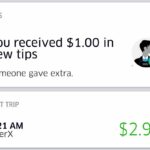Uber has signaled a revolution in how people can get around, even if they don’t have access to a car. However, Uber drivers tend to be subject to various regulations that may not always make a lot of sense.
Today, I’m going to explore whether you can drive for Uber in another state aside from the one you signed up in.
So can you Uber in another state? While you can only pick up passengers in the area that you’ve signed up in, you can drop off passengers in other states without any problems. In addition, there are some areas where Uber allows you to drive across state lines free of restrictions, though these tend to be few and far between.

While this may be a quick summary of whether or not you can Uber in another state, there are some exceptions and details that you’ll have to account for if you intend to do this regularly. I’m going to take a closer look at the details of driving for Uber across state lines and you can use that info to determine if you’ll be able to.
Can I Uber in Another State?
Let’s now consider the question – can I drive uber in another state? As we mentioned earlier, the simple fact is that you can certainly drop off people that you’ve picked up in your home state in a neighboring state. In fact, Uber drivers tend to love these kinds of fares because long-distance journeys mean that they waste less time moving from client to client.
Since the time you spend traveling or waiting for a client is essentially the unpaid time that you spend on the clock, then why not spend an extended period of time on the clock. Unfortunately, there’s also a downside to driving people to another state: getting back home so you can pick up more customers.
This is because you aren’t allowed to pick up clients in other states except for the one that you originally signed up in. While there are a few exceptions to this rule, they are only reserved for certain cities, and there’s no guarantee that Uber will let you pick people up in an adjacent state.
Uber drivers tend to be restricted to the state in that they signed up for the service for a variety of reasons. The first and most important reason is that different regions and states tend to have different regulations when it comes to things like ridesharing companies, so the drivers will be held to different standards.
A common difference between even neighboring states is that one state may require an in-depth background check so that you can drive as a ridesharing driver while another may not require as deep of one. This means that you can’t legally operate as a ridesharing driver in that other state unless you abide by their regulations.
Unfortunately, this means that you’re essentially unable to pick people up in neighboring states unless there is a similarity in how both of them operate or if they have a ridesharing agreement that makes this possible. When you apply for an Uber account, they approve you based on the regulations of your area alone.
Can You Uber to Another State? The Reasons Why You Can’t
Now that you know the answer to “can you drive Uber in another state”, you may be wondering why Uber can’t simply abide by the regulations of the neighboring state as well. And that brings us to the second reason why it’s hard to drive in another state. Since most drivers will only stay in their home state for pickups, Uber tends to see it as a waste of money, effort, and time to approve their drivers for multiple states.
One thing to note is that these restrictions didn’t always exist, and Uber was a lot more relaxed with how they considered driving across multiple states and territories. This was largely due to how most states and regions hadn’t yet enacted any laws or legislation based on ride-sharing.
However, as Uber and Lyft have gotten more and more popular, more states have decided to start creating laws and regulations about how they should operate. This eventually led to drivers being restricted based on where they originally signed up, which is where we currently find ourselves.
Exceptions to Regional Restrictions
As I’ve mentioned a few times, there are certain circumstances in which you can expect to be excluded from the restriction of driving in different states. To determine whether you’re eligible for this, it’s recommended that you contact Uber’s driver support line and see if they’re willing to make an exception.
There are also some cases where exceptions to the rule are given freely, such as when your Uber coverage area includes adjacent states. For example, drivers in places like New Jersey can expect to be able to drive in places like Pennsylvania, New York State (excluding New York City), and Connecticut.
This is especially true in smaller states like Rhode Island, where your coverage area can sometimes be bigger than the entirety of the state. Of course, this still depends on how the ridesharing regulations compare to the states around them. If the surrounding states have stricter regulations than your home state, you likely won’t be able to drive in them, without a special process.
For example, if you live in Delaware, you likely won’t be able to drive for Uber in Maryland because they have stricter regulations. However, you may be able to drive in New Jersey because of NJ’s more relaxed laws and regulations about how ride-sharing drivers are treated.
If the laws and regulations are relaxed in adjacent states, then you can expect to drive within about a 200-mile radius of your home city without any trouble. Once again, this depends on where you’re driving and where you intend to pick people up, so always do your research.
Another thing that you can do is change where you are based by contacting Uber driver support. Keep in mind that they don’t support temporary changes, so you will only be able to change where you are located if you are relocating for an extended period of time, which is typically a month or more.
Here’s How to Get Started
Getting started as an Uber driver requires some basic steps to get you up and running. Firstly, you’ll need to understand the process of becoming an Uber driver. This includes meeting certain requirements and passing background checks. To meet these requirements, you’ll need the following:
- A valid driver’s license,
- Valid car registration,
- Proof of your insurance,
- It’s also important to have a good driving record.
Once you’ve met these requirements, download the Uber app and fill out your profile information in order to get started. Next, you’ll need to select the type of vehicle you’d like to use for Uber; this will determine the types of trips you are eligible to accept. Finally, set up payment so that you can receive your earnings for each ride. Once you have all of this in place, you’ll be ready to start driving and picking up passengers.
Pick Up and Drop Off Freely in the Chosen Region
If you are in need of supplemental income, driving for Uber is a great option. If you find that you enjoy working as a ride-share driver, you can opt to do it full-time for reasonable pay, and 100% of tips. But, if you’re wondering – can I drive for uber in another state, you should pick one region where you’ll operate as an Uber driver. But this also means that you can pick up your clients and drop them off anywhere within that state because that’s where your registered region is.
Just keep in mind that in order to be an Uber driver or work for any other ride-sharing company, you should fulfill a specific set of requirements, as should your vehicle, too. Also, you should consider the fact that the amount of money you earn can vary based on the region, because different markets (and the time of day and the week when you drive) will determine your earnings.









